CWDM AND DWDM EXPLAINED
Wavelength Division Multiplexing (WDM) allows different data streams to be sent simultaneously over a single optical fiber network. The two key WDM technologies are Coarse Wavelength Division Multiplexing, CWDM and Dense Wavelength Division Multiplexing, DWDM. Which solution is best suited to a given environment depends on the network and user requirements.
Both technologies are independent of protocol, meaning that any mix of data, storage, voice or video can be used on the different wavelength channels. In fiber terms, the main difference between CWDM and DWDM technologies lies in how the transmission channels are spaced along the electromagnetic spectrum.
Coarse Wavelength Division Multiplexing - CWDM
CWDM supports up to 18 wavelength channels transmitted over a dark fiber at the same time. To achieve this, the different wavelengths of each channel are 20nm apart. Two wavelength regions are most commonly associated with CWDM, 1310nm and 1550nm. The 1550nm region is more popular because it has a lower loss in the fiber (meaning the signal can travel farther).
CWDM technology offers a convenient and cost-efficient solution for shorter distances of up to 70 kilometers. For distances between 40 and 70 kilometers, CWDM tends to be limited to supporting eight channels due to a phenomenon called the water peak of the fiber (more about this further down).
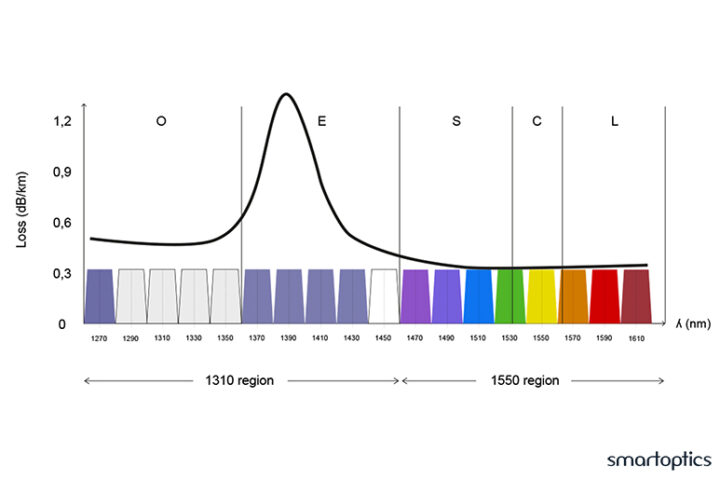
DWDM
DWDM supports up to 80 simultaneous wavelength channels, with each of the channels only 0.8nm apart. Unlike CWDM, DWDM connections can be amplified and can, therefore, be used for transmitting data much longer distances.
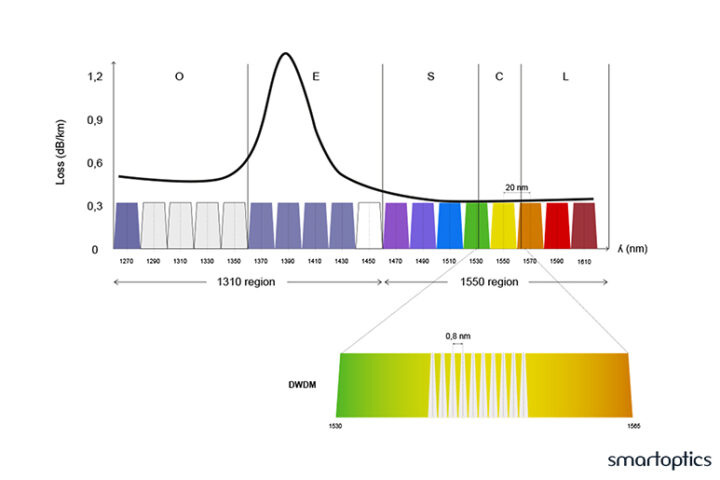
The sweet spot for CWDM is up to 10 Gigabit Ethernet and 16G Fibre Channel. And it is quite unlikely capacities with increase beyond this in the future. DWDM however, is able to handle higher speed protocols up to 100Gbps per channel making it a more suitable technology for higher speed protocols.
Traditionally CWDM components have been lower in cost making it more popular than DWDM. Now the price for both solutions is comparable. With higher speeds, more channel capacity, longer distances and passive networking, DWDM is the technology of choice for green field installations.
CWDM and DWDM wavelength comparison
The figure shows how the DWDM channels fit into the wavelength spectrum compared to CWDM channels. Each CWDM channel is spaced 20nm apart from the adjacent channel. In the figure, we use colors to differentiate the 8 CWDM channels in the 1550 region. For the 1310 regions, no color schemes have been standardized.
For DWDM on the other hand, most of the DWDM channels are within the 1530 and 1550nm CWDM regions. For DWDM channels, a color scheme has not been standardized either: probably just as well because remembering all the different colors for the DWDM channels with the naked eye might also be a strain. Instead, we use a block to indicate where they are grouped.

Why not just add more wavelengths?
CWDM and DWDM increase the amount of traffic that can be connected through a dark fiber. So why not just add more? The reason is that the characteristics of the fiber itself isn’t linear.
For longer distances, over 40 km, CWDM is restricted to 9 working channels due to a chemical property in the fiber called the water peak. The water peak is an area of high loss in the 1300nm region of the fiber that affects CWDM channels 1370nm to 1430nm. In this region, the signal loss is 1.0dB/km as opposed to 0.25dB/km in the 1550 region. This doesn’t mean that CWDM channels in the 1310nm region cannot be used, just that the distance is decreased.
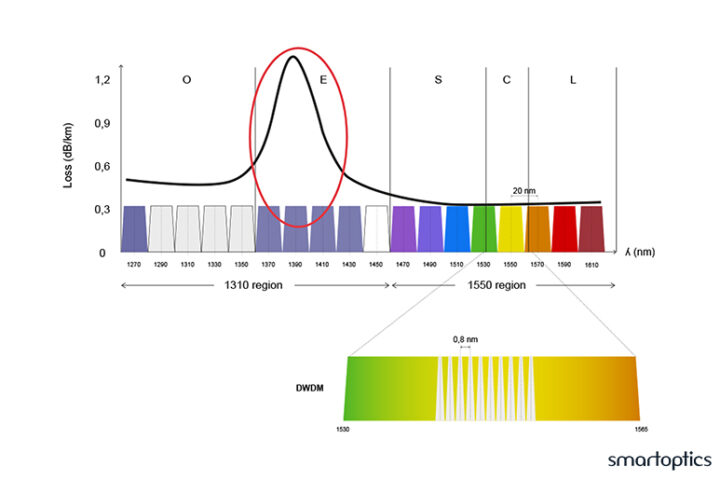
DWDM channels are in the 1550nm region of the fiber, which is the area in the fiber that has the lowest loss. The 1550 region is in a stable, low-loss valley surrounded by areas of high loss on either side. On either side of the 1550 region, the loss of the fiber quickly increases and becomes less suitable for optical networking applications.
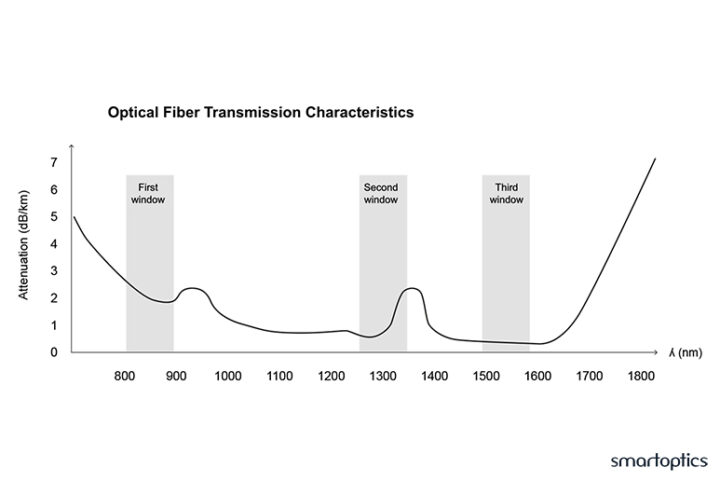
A convenient way to increase the number of DWDM channels is to use an interleaver. Read more about this here.
Should you use CWDM or DWDM?
As discussed, CWDM connectivity is limited to 70km, while DWDM can transmit up to 80km. But perhaps even more importantly, DWDM can be amplified for longer distances. Since all DWDM channels tend to predominantly sit in the “flattened-out” 1550nm range of the fiber, they lend themselves better to being amplified.
| CWDM vs DWDM | DWDM | CWDM |
| Distance, unamplified | 80km | 70km |
| Distance, amplified | 1000km+ | Not applicable |
| Channels | 88 (using interleaver) | 18 (distances limited in the water peak) |
| Spacing | 0.8nm | 20nm |
| Protocols | All including 100G and beyond: 1/10/40/100GE and 8/16/32GFC | Up to 10GE and 8GFC (40G using 4x10G CWDM) |
If a CWDM solution is already in place and the system still holds capacity for further growth, then CWDM should be considered. If the capacity is getting full, then there are two options: to start again with a DWDM system with a higher capacity or to overlay a “hybrid DWDM” network over the top of channels 1530 and 1550nm, which creates an additional 26 new channels over the existing CWDM network.
DWDM systems have traditionally been designed and used by telcos for fixed, vertically integrated systems, and as such have brought large real estate requirements. This is why CWDM was long the more popular choice for corporate data center connectivity. But today there are more flexible solutions for DWDM also at the corporate data center level, making it a much more realistic option.
What is CWDM and DWDM?
There are two main types of technology for wavelength division multiplexing (WDM): coarse (CWDM) and dense (DWDM). They both use multiple wavelengths of light on a single fiber, but differ in their spacing of the wavelengths, number of channels and ability to amplify the multiplexed signals.
Unlike CWDM, the wavelengths in DWDM are more tightly packed, and connections can be amplified. This means that data can be transmitted over much longer distances. CWDM has traditionally been a lower-cost solution, but today the prices for both are comparable. Deciding which solution is best depends on user and network requirements.


Related articles

What is a SAN and how does it protect mission-critical workloads?
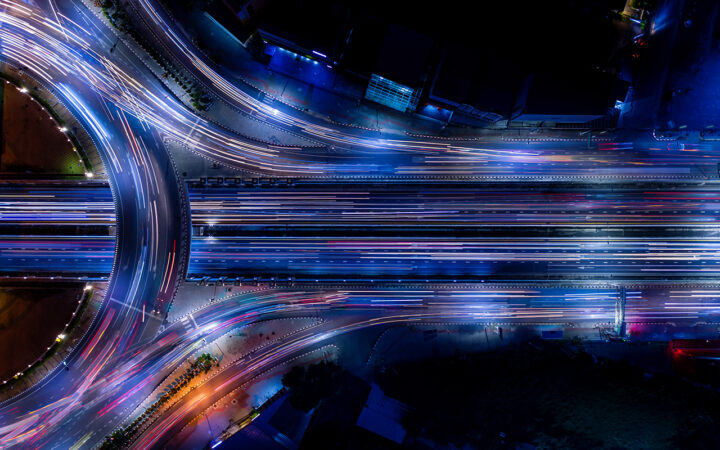
What is Fibre Channel used for?
